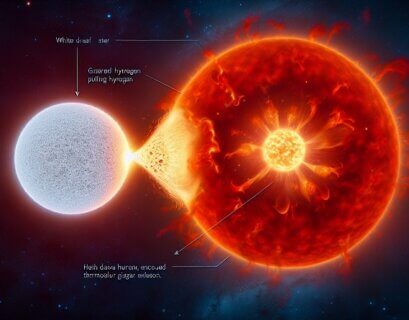Geophysics is an interesting area of study. It uses physics and mathematics to understand Earth’s systems. This includes exploring Earth’s physical properties like its composition, structure, and processes. Geophysicists gather and analyze data using different techniques and tools. They do this to learn more about Earth’s systems.
Understanding Earth’s systems is very important. It helps us know why natural events like earthquakes, volcanic eruptions, and climate change happen. Scientists study these events to make models and predictions. These can lessen the effects on people. Geophysics is also important for finding and managing resources. By knowing Earth’s makeup, geophysicists can find important resources like oil, gas, and minerals.
Key Takeaways
- Geophysics is the study of the Earth’s physical properties and processes.
- Geophysical survey techniques are used to gather data about the Earth’s subsurface.
- Electromagnetism plays a crucial role in geophysics, helping scientists to map the Earth’s magnetic field and detect mineral deposits.
- Plate tectonics is a key concept in geophysics, explaining how the Earth’s crust is made up of moving plates that interact with each other.
- GIS technology is important in high school geophysics classes, allowing students to analyze and visualize geospatial data.
Table of Contents
ToggleUnderstanding Geophysical Survey Techniques
Geophysical survey techniques gather information about the area beneath the Earth’s surface. They do this without needing to dig or drill. These techniques focus on measuring the Earth’s physical properties. Key aspects measured include the Earth’s magnetic field, its electrical conductivity, and the behavior of seismic waves. Geophysicists then analyze these measurements. This analysis helps them understand what is happening below the surface.
Magnetic surveying is a geophysical survey technique. It uses magnetometers to measure the Earth’s magnetic field. Changes in the magnetic field suggest underground structures or mineral deposits. This method is often used to find ore bodies in mineral exploration.
Electrical resistivity surveying uses electrodes to measure electrical resistance under the ground. Materials resist electricity differently. Geophysicists analyze these resistance values. They figure out what’s beneath the surface. This method is common in environmental studies. It helps find underground water and detect soil contamination.
The Role of Electromagnetism in Geophysics
Electromagnetism is important in geophysics. It uses electromagnetic waves to explore the Earth’s subsurface. This helps scientists learn about the Earth’s composition and structure. Electromagnetic waves combine electric and magnetic fields. These waves travel through space.
Electromagnetism plays a crucial role in geophysics. This is due to a process known as electromagnetic induction. This process involves observing how the underground layers of the Earth react to shifting magnetic fields. By analyzing these reactions, geophysicists can determine the electrical conductivity beneath the Earth’s surface. Knowing the electrical conductivity helps them understand the composition and structure of the underground. They frequently apply this method to locate minerals and assess groundwater conditions.
Electromagnetism is used in geophysics with ground-penetrating radar (GPR). This method sends high-frequency electromagnetic waves below the surface. The waves return when they hit different soil layers or buried objects. Geophysicists use these reflected waves to make detailed subsurface images. GPR is commonly used in archaeology to find buried structures or artifacts.
Learning Plate Tectonics: A Key Concept in Geophysics
Plate tectonics is an important idea in geophysics. It describes how the Earth’s outer shell, or lithosphere, moves. The lithosphere is made up of big plates that rest on a partly liquid layer called the asthenosphere. Convection currents in the asthenosphere make these plates move. As a result, the plates can bump into each other, move apart, or slide sideways past one another.
Understanding plate tectonics is essential to grasp many Earth events. It explains why earthquakes and volcanoes happen. When plates collide or move apart, they release a lot of energy. This energy causes earthquakes or volcanic eruptions. By looking at where plates meet and how they interact, experts can predict such events better.
Plate tectonics shape mountains and natural resource locations. When plates meet, intense pressure lifts the Earth’s crust, forming mountains. Plate movements can create rift valleys and oceanic trenches. These spots might hold oil, gas, or minerals.
The Importance of GIS in High School Geophysics Classes
Geographic Information Systems (GIS) are important in geophysics. They help scientists study and understand spatial data. GIS is a computer system. It brings together geographic data and attribute data. This allows for the creation of maps and spatial analysis.
GIS is crucial for high school geophysics. It lets students study real data. With GIS software, they can make maps, look at spatial patterns, and do simulations. This practical method boosts their critical thinking. It also helps them understand geophysics better.
GIS helps study earthquakes in geophysics. It maps where earthquakes happen and their strength. Students find patterns and see how earthquakes spread. This helps learn about plate tectonics and how earthquakes relate to plate edges.
Students use GIS to examine climate data. They map temperature and rainfall. It helps them to find climate patterns. Students also study how equator distance, elevation, and water proximity impact these patterns. This teaches them about Earth’s systems and climate change interaction.
Exploring Earth’s Magnetic Field
The Earth’s core creates a magnetic field that reaches out into space. This field comes from molten iron moving in the Earth’s outer core. It is very important in the study of the Earth and has many uses.
In geophysics, one method to study the Earth’s magnetic field is called magnetic surveying. This method looks at changes in the magnetic field. These changes can show where underground formations or minerals are. By charting these changes, geophysicists can find valuable resources or learn about an area’s geological past.
The Earth’s magnetic field helps with navigation. Compasses align with this field, helping sailors and explorers find their way. The magnetic field also shields Earth from dangerous solar radiation. It deflects charged particles from the Sun.
Mysteries of Earthquakes and Seismic Waves

Earthquakes are one of the most fascinating and destructive natural phenomena on Earth. They occur when there is a sudden release of energy in the Earth’s crust, causing the ground to shake. Seismic waves are the vibrations that travel through the Earth during an earthquake.
Geophysicists study earthquakes and seismic waves to better understand their causes and effects. By analyzing seismic waves, scientists can determine the location, magnitude, and depth of an earthquake. This information is crucial for assessing earthquake hazards and developing strategies to mitigate their impact.
Seismic waves are also used to study the structure of the Earth’s interior. Different types of seismic waves travel at different speeds and are affected by different materials. By analyzing how seismic waves propagate through the Earth, geophysicists can infer information about its composition and structure.
The Science of Volcanoes: A Geophysical Perspective
Volcanoes are another fascinating natural phenomenon that geophysicists study. Volcanoes are formed when molten rock called magma rises to the surface through cracks in the Earth’s crust. When this magma reaches the surface, it erupts, releasing gases, ash, and lava.
Geophysicists study volcanoes to better understand their behavior and predict eruptions. By monitoring volcanic activity, scientists can detect changes in gas emissions, ground deformation, or seismic activity that may indicate an impending eruption. This information is crucial for issuing warnings and evacuating nearby populations.
Volcanoes also provide valuable insights into the Earth’s interior. By studying the composition of volcanic rocks and gases, geophysicists can gain insights into the processes occurring deep within the Earth. Additionally, volcanic eruptions can have a significant impact on climate by releasing large amounts of gases and ash into the atmosphere.
Investigating the Earth’s Interior: Seismic Tomography
Seismic tomography is a technique used to image the Earth’s interior using seismic waves. It involves analyzing how seismic waves travel through the Earth and using this information to create detailed images of its structure.
Seismic tomography is important in geophysics because it allows scientists to study the Earth’s interior without physically drilling into it. By analyzing seismic wave data from earthquakes or controlled explosions, geophysicists can create three-dimensional images of the Earth’s structure.
This technique has been used to study the Earth’s core, mantle, and crust. It has provided valuable insights into the composition and dynamics of these regions. For example, seismic tomography has helped scientists understand the movement of tectonic plates and the formation of mountain ranges.
Basics of Computational Geophysics
Computational geophysics is a branch of geophysics that utilizes mathematical and computational techniques to analyze and interpret geophysical data. The basics of computational geophysics involve understanding the fundamental principles of geophysics and applying them to data processing, modeling, and interpretation. This includes techniques such as signal processing, numerical methods, and data analysis. In addition, a strong background in mathematics, physics, and computer science is essential to effectively utilize computational tools in geophysics. By integrating computational methods with traditional geophysical techniques, computational geophysicists can effectively improve the accuracy and efficiency of data interpretation, leading to a better understanding of the Earth’s structure and processes.
Geophysics and Climate Change: How Earth’s Systems Interact
Geophysics plays a crucial role in studying climate change and understanding how Earth’s systems interact. Climate change refers to long-term changes in temperature, precipitation patterns, and other climate variables. It is primarily driven by human activities such as burning fossil fuels and deforestation.
Geophysicists use a variety of techniques to study climate change. For example, they use satellite data to monitor changes in the Earth’s surface temperature, sea level, and ice cover. They also use models and simulations to understand how changes in greenhouse gas concentrations affect the Earth’s climate.
Understanding how Earth’s systems interact is crucial for predicting the impacts of climate change. For example, changes in temperature can affect the distribution of precipitation, which in turn can affect agriculture and water resources. Changes in sea level can lead to coastal erosion and flooding. By studying these interactions, geophysicists can develop strategies to mitigate the impacts of climate change.
Conclusion
Geophysics is a fascinating field of study that plays a crucial role in understanding the Earth’s systems. By using a variety of techniques and tools, geophysicists gather data about the Earth’s composition, structure, and processes. This information is crucial for a wide range of applications, from predicting earthquakes and volcanic eruptions to studying climate change.
For teenagers interested in science and the natural world, geophysics offers an exciting opportunity to explore and understand the Earth’s systems. By studying geophysics, teenagers can develop critical thinking skills, gain hands-on experience with data analysis tools such as GIS, and contribute to our understanding of the Earth.
So if you’re a teenager with a passion for science and a curiosity about the world around you, consider exploring geophysics as a potential field of study. It offers endless opportunities for discovery and has the potential to make a real impact on our understanding of the Earth’s systems.
If you’re interested in learning more about the basics of geophysics, you’ll definitely want to check out Geophysics in Action: Understanding Earth’s Processes through Scientific Investigation article on Entech Online. Don’t miss out on expanding your knowledge and understanding of the fascinating field of geophysics! Click here to read the article now.
FAQs
What is geophysics?
Geophysics is the study of the physical properties and processes of the Earth and other planets.
What are the different branches of geophysics?
The different branches of geophysics include seismology, geomagnetism, geoelectricity, gravity, and geothermal studies.
What is seismology?
Seismology is the study of earthquakes and seismic waves that travel through and around the Earth.
What is geomagnetism?
Geomagnetism is the study of the Earth’s magnetic field and its variations.
What is geoelectricity?
Geoelectricity is the study of the electrical properties of the Earth’s crust and upper mantle.
What is gravity?
Gravity is the force that attracts two bodies towards each other. In geophysics, gravity is used to study the Earth’s interior structure.
What is geothermal studies?
Geothermal studies involve the study of the Earth’s heat and its transfer from the interior to the surface. It is used to study geothermal energy and the Earth’s thermal history.
Why is geophysics important?
Geophysics is important because it helps us understand the Earth’s structure, processes, and history. It also helps us locate and extract natural resources, study natural hazards such as earthquakes and volcanoes, and understand climate change.
Author
-

Until 2023, Dr. Charudatta S Pathak held multiple academic positions, including lecturer, assistant professor, professor, dean, principal, director, and vice chancellor at public and private universities across India. From 2008 to 2010, he held the position of project lead in the CAE department at a European multinational corporation. Throughout his 28-year professional experience, he observed a requirement for reliable publications aimed at youngsters in grades 8 to 12, specifically for early-stage career planning. He initiated the establishment of ENTECH Digital Magazine, a complimentary periodical released on a monthly basis, accessible via entechonline.com and magzter.com. Teenagers with a keen interest in Science, Technology, Engineering, and Mathematics (STEM) and aspiring to pursue professional paths in these domains can consider reading ENTECH Digital Magazine.
View all postsRecent Posts












